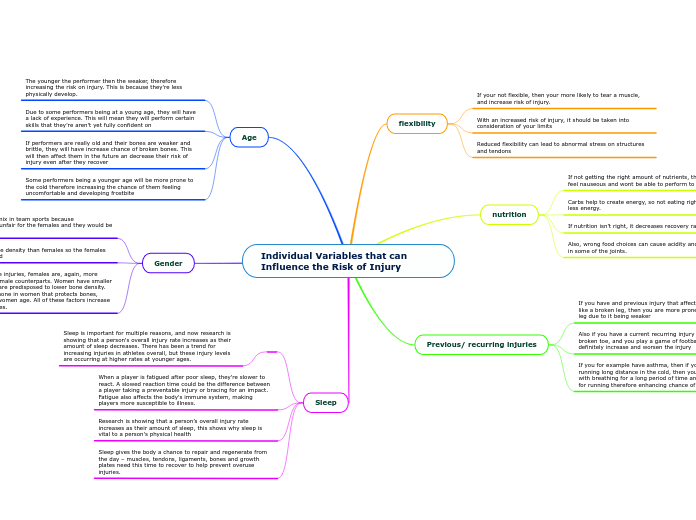Individual Variables that can Influence the Risk of Injury
flexibility
If your not flexible, then your more likely to tear a muscle, and increase risk of injury.
With an increased risk of injury, it should be taken into consideration of your limits
Reduced flexibility can lead to abnormal stress on structures and tendons
nutrition
If not getting the right amount of nutrients, they may start to feel nauseous and wont be able to perform to their best.
Carbs help to create energy, so not eating right will result in less energy.
If nutrition isn't right, it decreases recovery rate
Also, wrong food choices can cause acidity and inflammation in some of the joints.
Previous/ recurring injuries
If you have and previous injury that affected you in the past like a broken leg, then you are more prone to another broken leg due to it being weaker
Also if you have a current recurring injury for example a broken toe, and you play a game of football, you will most definitely increase and worsen the injury
If you for example have asthma, then if you are for example running long distance in the cold, then you will have problems with breathing for a long period of time and using your breath for running therefore enhancing chance of injury
Age
The younger the performer then the weaker, therefore increasing the risk on injury. This is because they're less physically develop.
Due to some performers being at a young age, they will have a lack of experience. This will mean they will perform certain skills that they're aren't yet fully confident on
If performers are really old and their bones are weaker and brittle, they will have increase chance of broken bones. This will then affect them in the future an decrease their risk of injury even after they recover
Some performers being a younger age will be more prone to the cold therefore increasing the chance of them feeling uncomfortable and developing frostbite
Gender
Both genders cannot mix in team sports because
it would be physically unfair for the females and they would be injured.
Males have higher bone density than females so the females are likely to get injured
When it comes to bone injuries, females are, again, more susceptible than their male counterparts. Women have smaller bone dimensions and are predisposed to lower bone density. Also, estrogen, a hormone in women that protects bones, decreases sharply as women age. All of these factors increase the risk of broken bones.
Sleep
Sleep is important for multiple reasons, and now research is showing that a person's overall injury rate increases as their amount of sleep decreases. There has been a trend for increasing injuries in athletes overall, but these injury levels are occurring at higher rates at younger ages.
When a player is fatigued after poor sleep, they're slower to react. A slowed reaction time could be the difference between a player taking a preventable injury or bracing for an impact. Fatigue also affects the body's immune system, making players more susceptible to illness.
Research is showing that a person’s overall injury rate increases as their amount of sleep, this shows why sleep is vital to a person's physical health
Sleep gives the body a chance to repair and regenerate from the day – muscles, tendons, ligaments, bones and growth plates need this time to recover to help prevent overuse injuries.
